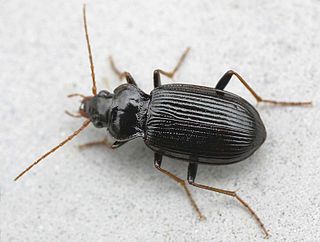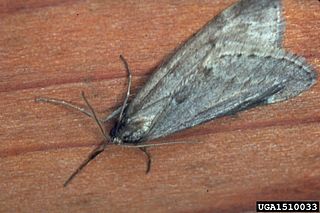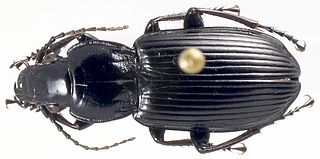
Silphidae is a family of beetles that are known commonly as large carrion beetles, carrion beetles or burying beetles. There are two subfamilies: Silphinae and Nicrophorinae. Members of Nicrophorinae are sometimes known as burying beetles or sexton beetles. The number of species is relatively small, at around two hundred. They are more diverse in the temperate region although a few tropical endemics are known. Both subfamilies feed on decaying organic matter such as dead animals. The subfamilies differ in which uses parental care and which types of carcasses they prefer. Silphidae are considered to be of importance to forensic entomologists because when they are found on a decaying body they are used to help estimate a post-mortem interval.

The common cockchafer, also colloquially known as the Maybug, Maybeetle, or doodlebug, is a species of scarab beetle belonging to the genus Melolontha. It is native to Europe, and it is one of several closely-related and morphologically similar species of Melolontha called cockchafers, alongside Melolontha hippocastani.

Aethina tumida,commonly known as small hive beetle (SHB), is a beekeeping pest. It is native to sub-Saharan Africa, but has spread to many other regions, including North America, Australia, and the Philippines.

The scarlet lily beetle, red lily beetle, or lily leaf beetle, is a leaf beetle that eats the leaves, stem, buds, and flowers, of lilies, fritillaries and other members of the family Liliaceae. It lays its eggs most often on Lilium and Fritillaria species. In the absence of Lilium and Fritillaria species, there are fewer eggs laid and the survival rate of eggs and larvae is reduced. It is now a pest in most temperate climates where lilies are cultivated.

The Asilidae are the robber fly family, also called assassin flies. They are powerfully built, bristly flies with a short, stout proboscis enclosing the sharp, sucking hypopharynx. The name "robber flies" reflects their expert predatory habits; they feed mainly or exclusively on other insects and, as a rule, they wait in ambush and catch their prey in flight.

The raspberry beetle is a species of beetle in the fruitworm family Byturidae. It is a major pest that is widespread in north-central Europe, affecting raspberry, blackberry and loganberry plants.

Dermolepida albohirtum, the cane beetle, is a native Australian beetle and a pest of sugarcane. Adult beetles eat the leaves of sugarcane, but greater damage is done by their larvae hatching underground and eating the roots, which either kills or stunts the growth of the plant. The beetles can also be found in the Philippines and are known there by the local name salagubang.

Deroceras reticulatum, common names the "grey field slug", "grey garden slug", and "milky slug", is a species of small air-breathing land slug, a terrestrial pulmonate gastropod mollusc in the family Agriolimacidae. This species is an important agricultural pest.

Nicrophorus vespillo is a burying beetle described by Carl Linnaeus in his landmark 1758 10th edition of Systema Naturae. It has a paleartic distribution and is commonly found across Europe and Asia, extending from Western Europe to Mongolia.

Calosoma is a genus of large ground beetles that occur primarily throughout the Northern Hemisphere, and are referred to as caterpillar hunters or caterpillar searchers. Many of the 167 species are largely or entirely black, but some have bright metallic coloration. They produce a foul-smelling spray from glands near the tip of the abdomen. They are recognizable due to their large thorax, which is almost the size of their abdomen and much wider than their head.

Calosoma inquisitor is a species of ground beetle. The species is found in northern Africa, Europe and East to Asia Minor, Iran and the Caucasus, with isolated populations in eastern Siberia and Japan.

Nebria brevicollis, belonging to the Carabidae family, is a ground beetle. With nearly 500 species and over 100 subspecies, N. brevicollis is the most diverse genus within the Nebriini tribe of ground beetles. Members of the genus occupy a wide range of habitats. Nebria brevicollis is native to Europe and the Near East but has been introduced to the western United States and Canada. Its rapid expansion in North America is characteristic of an invasive species. Due to the variation in habitat, their diet consists of small arthropods including Collembola, Diptera, earthworms, mites, and spiders.

Anisoplia austriaca is the binomial name of a species of scarab beetle, a harmful pest of cereal crops. Its body length is 12–16 mm.

Alsophila pometaria, the fall cankerworm, is a moth of the family Geometridae. It is found in North America from Nova Scotia west to Alberta, south to Colorado and California and zones of Spain

The European chafer is a beetle of the family Scarabaeidae. Formerly found only in continental Europe, this invasive species is now found at temperate latitudes in North America. The large, white grubs of A. majale feed on the roots of most cool-latitude grasses, both wild and cultivated. This has made the European chafer an enemy of lawns.

Cerotoma trifurcata is a species of beetle in the Chrysomelidae family that can be found in the Eastern and West United States.

Phyllopertha horticola, the garden chafer or garden foliage beetle, is a beetle from the family Scarabaeidae. Phyllopertha horticola was described by Carl Linnaeus in his landmark 1758 10th edition of Systema Naturae.

Pterostichus melanarius, the Rain Beetle, is a type of carabid of the genus Coleoptera. It is native to Europe but is increasingly found in North America after being introduced to the region in the 1920s. It is a predatory beetle that eats invertebrate pests, which makes it a valuable pest control agent in agricultural settings. Additionally, the beetle has wing dimorphism which has contributed to its increasing distribution across North America.

Apion apricans is a species of seed weevils native to Europe. It is widespread everywhere. Damages clover and wild. The beetle is 3–3.5 mm in size, black, with a metallic hue, the body is pear-shaped, the legs are partially yellow; rostrum long, almost straight; apex of antennae black, base - red. Egg - 0.3-0.5 mm, yellowish, long, smooth. Larva 2–2.5 mm, white with a creamy hue, curved, dark brown head, on the upper jaws on each side of three growths, the middle of them increased; instead of legs six pairs of small knolls. Pupa 3–3.5 mm, yellowish white.

Calopteron reticulatum, also known as the reticulated net-winged beetle, is a species of net-winged beetle in the family Lycidae. It is also known as the banded net-winged beetle, though that name is also used for the closely related and similarly banded Calopteron discrepans. It is found in North America. Adults are active during the day, and lay their eggs on dead/decaying trees. The species also pupates in dead trees. Larva hunt in leaf litter, eating other small arthropods.





















